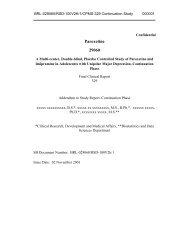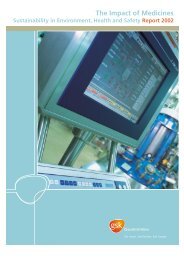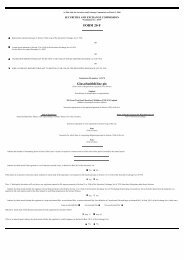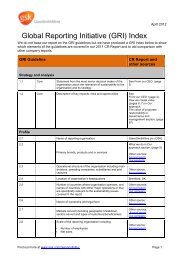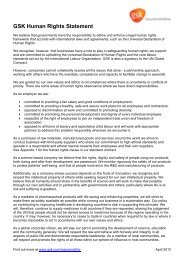GSK Annual Report 2002
GSK Annual Report 2002
GSK Annual Report 2002
Create successful ePaper yourself
Turn your PDF publications into a flip-book with our unique Google optimized e-Paper software.
Operating activities<br />
Marketing and distribution<br />
GlaxoSmithKline sells its products worldwide through an<br />
extensive network of subsidiaries, licensees and distributors.<br />
The gross profit margins earned on sales of pharmaceutical<br />
products are generally higher than those earned on sales of<br />
consumer products, reflecting the many risks and uncertainties<br />
inherent in developing and marketing pharmaceuticals. These risks<br />
include the high level of research and development expenditure<br />
required to discover, test and obtain patent protection for new<br />
products and the competition from new and generic products.<br />
GlaxoSmithKline’s worldwide operation is subject to a number of<br />
risks inherent in conducting business in certain countries, including<br />
possible nationalisation, expropriation and other restrictive<br />
government actions such as capital regulation. In addition, currency<br />
fluctuations and other changes in economic conditions may occur,<br />
which can have either a favourable or unfavourable effect on<br />
trading income. The Group does not regard these factors as<br />
deterrents to further expansion of its international operations.<br />
However, it closely reviews its methods of operation, particularly in<br />
developing countries, and develops strategies to respond to<br />
changing economic and political conditions.<br />
Marketing and distribution – Pharmaceuticals<br />
An analysis of total pharmaceutical sales, including in 2000<br />
divested products, by geographic region is set out below:<br />
<strong>2002</strong> 2001 2000<br />
Sales by geographic region £m £m £m<br />
USA 9,797 9,037 7,705<br />
Europe 4,701 4,561 4,268<br />
International:<br />
Asia Pacific 1,177 1,119 1,049<br />
Japan 712 741 832<br />
Latin America 606 790 682<br />
Middle East, Africa 575 539 511<br />
Canada 427 418 382<br />
17,995 17,205 15,429<br />
GlaxoSmithKline sells its prescription medicines primarily to<br />
wholesale drug distributors, independent and chain retail<br />
pharmacies, physicians, hospitals, clinics, government entities and<br />
other institutions. These products are ordinarily dispensed to the<br />
public by pharmacies through prescriptions written by doctors in<br />
hospitals or in doctors’ surgeries.<br />
In the USA, the world’s largest pharmaceutical market, the<br />
pressure to contain healthcare costs has encouraged the growth<br />
of managed care organisations and pharmacy benefit managers.<br />
These intermediaries use a range of methods to lower costs,<br />
including the substitution of generic products or other cheaper<br />
therapies for branded products prescribed by doctors. Because of<br />
its increasing importance as a supplier of healthcare to the<br />
community, GlaxoSmithKline contracts with the managed care<br />
sector through a small number of wholesalers.<br />
In each market, GlaxoSmithKline deploys salesforces of<br />
representatives and supporting medical staff to promote its<br />
prescription products to medical prescribers and healthcare<br />
purchasers through personal visits.<br />
Promotion of GlaxoSmithKline’s products is supplemented by<br />
scientific seminars, advertising in medical and other journals,<br />
television advertising, provision of samples, direct mailing and<br />
information contained on the Group’s website.<br />
Description of business GlaxoSmithKline 13<br />
Direct-to-consumer (DTC) advertising is a major component of<br />
product marketing in the USA. DTC advertisements are now the<br />
primary source of information for patients requesting specific<br />
brand name products from their physicians in the USA.<br />
Outside the USA, DTC is either prohibited or has a more limited<br />
role in informing patients. In the European Union, DTC of<br />
prescription-only products is currently prohibited. In Australia, the<br />
government allows DTC advertising of pharmacy-only products<br />
subject to certain safeguards. In New Zealand, DTC is allowed and<br />
self-regulated by the industry in collaboration with the Advertising<br />
Standards Agency. Other markets allow DTC, but to date the<br />
impact has been more limited.<br />
In addition to the direct marketing of products by its subsidiaries<br />
GlaxoSmithKline has entered into agreements with other<br />
pharmaceutical companies for the co-marketing and co-promotion<br />
of their products in many markets, for example Levitra with Bayer.<br />
Marketing and distribution – Consumer Healthcare<br />
The principal markets for Consumer Healthcare’s OTC medicines<br />
are the USA, the UK, Germany, Australia, Argentina, Italy, Mexico,<br />
Japan, Canada and France. The principal markets for the Oral care<br />
products are the USA, Germany and the UK. The nutritional drinks<br />
business is particularly strong in the UK, Ireland and India, although<br />
the range of products is available in other markets.<br />
OTC and Oral care products are primarily distributed through<br />
pharmacy or mass market outlets either directly or through<br />
wholesalers. Nutritional healthcare products are distributed through<br />
a similar but more extensive retail and wholesale network.<br />
Manufacture and supply<br />
GlaxoSmithKline has a large portfolio of products, ranging from<br />
tablets and toothpaste to inhalers and complex capsules, in over<br />
36,000 different pack sizes and presentations.<br />
Manufacture of medicines begins with the development of a<br />
therapeutic active ingredient (bulk active) in a selected formulation.<br />
Global Manufacture & Supply (GMS) develops manufacturing<br />
processes for full scale volume production of active compounds at<br />
'primary' manufacturing sites. Converting active compounds into a<br />
finished dosage formulation is the responsibility of the 'secondary'<br />
manufacturing sites.<br />
GMS operates as a single global network of 95 sites in 38<br />
countries. Each year GMS produces around 5,900 tonnes of bulk<br />
actives and over four billion packs, which are packaged and<br />
delivered for sale in over 150 countries. Throughout the world it<br />
also supports approximately 2,000 new product and line extension<br />
launches a year.<br />
GMS is focused on delivering:<br />
• a secure source of supply of high quality products<br />
• compliance with regulatory requirements and customer<br />
expectations<br />
• best in class cost<br />
• leading edge practices and performance – at sites, in<br />
procurement and in other global functions.<br />
Organisation<br />
GMS operations are structured into Supply Chains and Regions.








